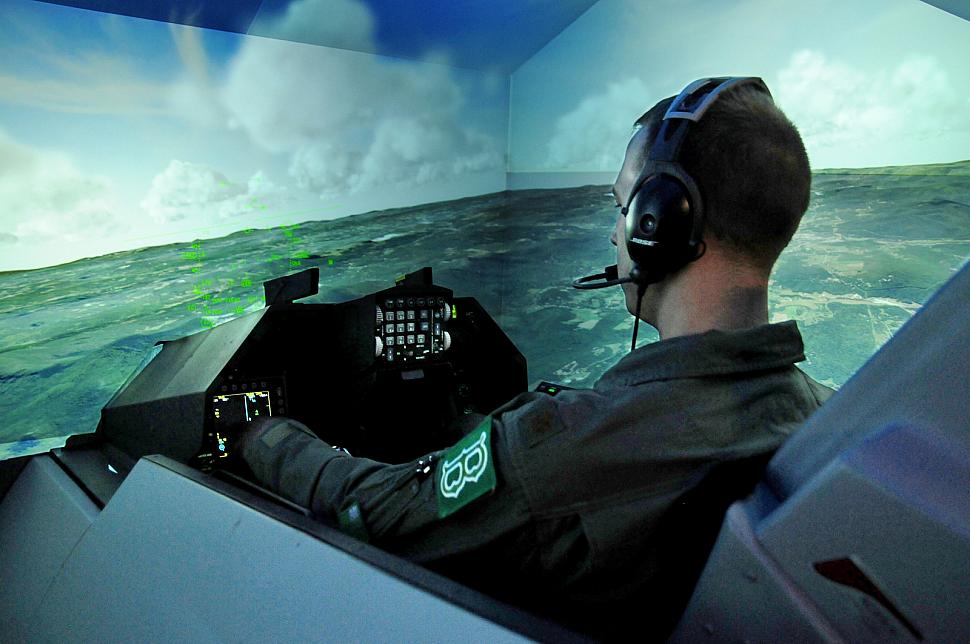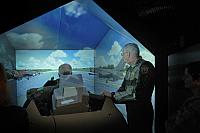Fighter Jet News
F-16 Fighting Falcon News
MetaVR's Visual Systems in new F-16 MTC at VTANG facilities
June 23, 2010 (by
MetaVR, Inc.) -
The new F-16 Mission Training Center (MTC) located at the Vermont Air National Guard (ANG) facilities at the Burlington International Airport, Burlington, VT officially opened for operation on June 4, 2010.
The ribbon cutting ceremony included remarks from U.S. Sen. Patrick Leahy, Lt. Gen. Christopher D. Miller, the Air Force's deputy chief of staff for strategic plans and programs, and top National Guard officials.
Visitors to the MTC Open House that followed the ribbon cutting event saw demonstrations on the simulators consisting of scenarios of a civil air defense alert and an armed overwatch escorting a convoy in virtual Afghanistan.
The F-16 MTC's mission is to train F-16 fighter pilots from across the U.S. in a first-of-its-kind graduate-level setting to provide advanced pilot mission training and mission rehearsal.
The contractor team International Simulation & Training Systems (ISTS), Lockheed Martin, and MetaVR contributed to this facility.
The F-16 MTC uses over 90 MetaVR Virtual Reality Scene Generator (VRSG) licenses in their four-ship simulators. MetaVR also built and delivered to the MTC high resolution geospecific 3D terrain of the ANG base facilities and airfield, which is used in the F-16 simulation training.
The site consists of 4 F-16 full mission trainers, instructor/operator stations (IOS) for each cockpit, and an after-action review capability. Each cockpit consists of a 360-degree wraparound display based on the A10 FMT seamless M2-DART display. The original M2-DART display used one projector for each of the 8 display facets. The ISTS/LMCO team enhanced this design by using 2 or 3 projectors on each of the 8 display facets, for a total of 18 HD projectors.
Inside the wraparound display sets a high-fidelity cockpit with functional buttons, switches, and multi-function displays (MFDs). The MFDs can display targeting pod video in Electro Optic (EO), Infrared (IR), or ground-mapping radar.
An instructor/operator station (IOS) exists for each cockpit. The IOS establishes the environment the simulator will fly in, to include geographic location, weather, time-of-day. The IOS also controls the threat environment using the AFRL XCITE target generator. The IOS includes a large flat-screen TV that can simultaneously display a replica of out-the-window scene, heads-up display, and both multi-function displays.
Unique to this installation is its novel approach to Night Vision Goggle (NVG) training. The visual system uses a stimulate approach rather than simulate approach to NVG training. The pilot wears his real NVGs while in the cockpit, so he can become accustomed to the form-factor and limited field-of-view.
The pilot is head-tracked with 6 degrees of freedom, enabling the image generator to know at any moment the exact location and viewing direction of the pilots head. The image generator renders an NVG Area of Interest (AOI) inside a cone visible to the goggles. Imagery rendered inside the NVG AOI is modified to stimulate NVGs and display covert lights. Imagery rendered outside the NVG AOI is rendered as normal unaided-eye, and covert lights are not visible outside the NVG AOI. This forces the pilots to look through the NVGs to be able to see the scene in sufficient detail at night for flying.
At the F-16 MTC, ten pilots can be trained at a time in exercises conducted on a local network or in Distributed Mission Operations (DMO) collaboration with the Iowa Air National Guard's Distributed Training Operations Center (DTOC) in Des Moines, IA.
Visitors to the MTC Open House that followed the ribbon cutting event saw demonstrations on the simulators consisting of scenarios of a civil air defense alert and an armed overwatch escorting a convoy in virtual Afghanistan.
The F-16 MTC's mission is to train F-16 fighter pilots from across the U.S. in a first-of-its-kind graduate-level setting to provide advanced pilot mission training and mission rehearsal.
The contractor team International Simulation & Training Systems (ISTS), Lockheed Martin, and MetaVR contributed to this facility.
The F-16 MTC uses over 90 MetaVR Virtual Reality Scene Generator (VRSG) licenses in their four-ship simulators. MetaVR also built and delivered to the MTC high resolution geospecific 3D terrain of the ANG base facilities and airfield, which is used in the F-16 simulation training.
The site consists of 4 F-16 full mission trainers, instructor/operator stations (IOS) for each cockpit, and an after-action review capability. Each cockpit consists of a 360-degree wraparound display based on the A10 FMT seamless M2-DART display. The original M2-DART display used one projector for each of the 8 display facets. The ISTS/LMCO team enhanced this design by using 2 or 3 projectors on each of the 8 display facets, for a total of 18 HD projectors.
Inside the wraparound display sets a high-fidelity cockpit with functional buttons, switches, and multi-function displays (MFDs). The MFDs can display targeting pod video in Electro Optic (EO), Infrared (IR), or ground-mapping radar.
An instructor/operator station (IOS) exists for each cockpit. The IOS establishes the environment the simulator will fly in, to include geographic location, weather, time-of-day. The IOS also controls the threat environment using the AFRL XCITE target generator. The IOS includes a large flat-screen TV that can simultaneously display a replica of out-the-window scene, heads-up display, and both multi-function displays.
Unique to this installation is its novel approach to Night Vision Goggle (NVG) training. The visual system uses a stimulate approach rather than simulate approach to NVG training. The pilot wears his real NVGs while in the cockpit, so he can become accustomed to the form-factor and limited field-of-view.
The pilot is head-tracked with 6 degrees of freedom, enabling the image generator to know at any moment the exact location and viewing direction of the pilots head. The image generator renders an NVG Area of Interest (AOI) inside a cone visible to the goggles. Imagery rendered inside the NVG AOI is modified to stimulate NVGs and display covert lights. Imagery rendered outside the NVG AOI is rendered as normal unaided-eye, and covert lights are not visible outside the NVG AOI. This forces the pilots to look through the NVGs to be able to see the scene in sufficient detail at night for flying.
At the F-16 MTC, ten pilots can be trained at a time in exercises conducted on a local network or in Distributed Mission Operations (DMO) collaboration with the Iowa Air National Guard's Distributed Training Operations Center (DTOC) in Des Moines, IA.
Courtesy of Metavr
Additional images:
Related articles:
Forum discussion:
Tags
- L-3 Awarded F-16 Mission Training Center Contract Option (2010-03-14)
- Boeing awarded F-16 Mission Training Center contract (2007-05-09)
- Lockheed Martin adds Night Vision Goggle capability to USAF F-16 MTC (2004-12-03)
- F-16 Fighting Falcon news archive
Forum discussion:
- Start a discussion about this article in the F-16.net forum.
Tags


